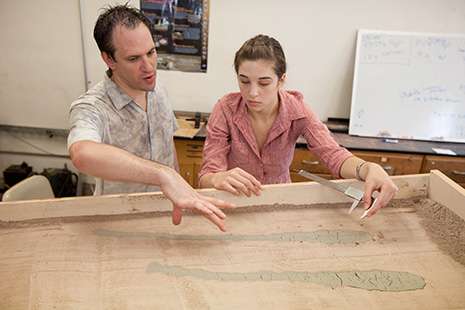Model suggests water could flow on Mars: Researchers look at melting and evaporation of frozen brines

(Phys.org)—University of Arkansas researchers have created a model that might explain how water could produce the flow patterns seen by a spacecraft orbiting Mars.
Research professor Vincent Chevrier and former Doctoral Academy Fellow Edgard Rivera-Valentin, now a postdoctoral associate at Brown University, published their findings in a recent edition of the journal Geophysical Research Letters.
The University of Arkansas researchers studied small flow features originally identified by NASA's Mars Reconnaissance Orbiter and detailed in a July 2011 paper published in Science magazine. These flow features, which appear and disappear with the seasons and show a strong preference for equator facing slopes, indicate the possible presence of liquid on the Red Planet. Chevrier and Rivera-Valentin have constructed the most comprehensive model to date of the behavior of water-and-salt combinations called brines to show that frozen water could melt, flow and then evaporate, creating these flow features on Mars.
Salts can lower the melting point of water, so the researchers used different forms of salt known to form on Mars to calculate what would melt, how much would become liquid and how long the liquid would last from the time it went from freezing to evaporation. They based their model on soils up to 20 centimeters deep, because beyond that depth the seasonal temperatures would not affect the freezing and melting aspects of the salt-water mixtures.
"We had to find a salt-water mixture that would come and go," in other words, something not completely liquid or solid, said Chevrier, a research assistant professor in the Arkansas Center for Space and Planetary Sciences in the J. William Fulbright College of Arts and Sciences. They found that calcium chloride fits the bill.
"In one day we could form enough liquid to create these flow features on the surface," he said. The researcher's model also explained why the flow features disappeared by incorporating evaporation into the model.
"The easier it becomes to melt, the easier it becomes to evaporate," Chevrier said. At low concentrations of brine, "as soon as it melts, it evaporates and disappears." However, the researchers showed that they could melt enough brine so that it would not completely evaporate, thus creating conditions that might explain the flow features.
Their model fits with the seasonal change in flow observations, with the flows occurring on equator facing slopes and with seasonal changes. Also, high surface evaporation rates as demonstrated in their model explain why, if there is water, it would disappear relatively quickly and why imaging spectrometry on Mars has not identified water signatures.
"No other current model really explains all the observations," Chevrier said.
Journal information: Geophysical Research Letters , Science
Provided by University of Arkansas

















